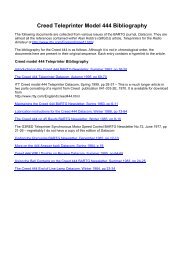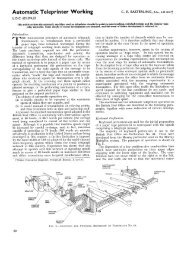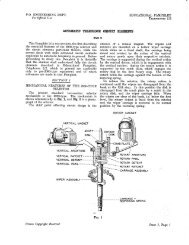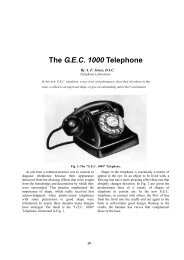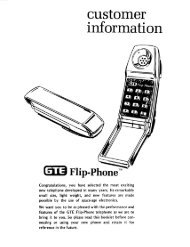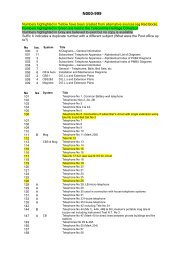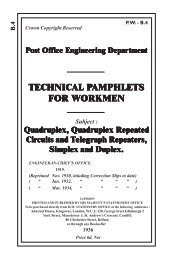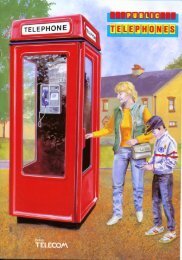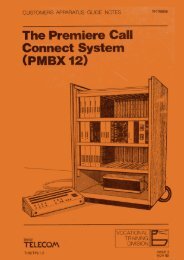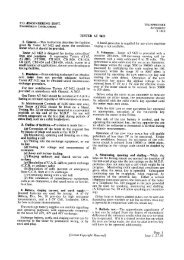TRAFFIC CONTROL TELEPHONE SYSTEMS Circuit - Sam Hallas
TRAFFIC CONTROL TELEPHONE SYSTEMS Circuit - Sam Hallas
TRAFFIC CONTROL TELEPHONE SYSTEMS Circuit - Sam Hallas
You also want an ePaper? Increase the reach of your titles
YUMPU automatically turns print PDFs into web optimized ePapers that Google loves.
Page 40<br />
The total number of code settings which are applicable is 66, as shown in Code Table<br />
No. 1, page 25. The possibility of requiring more than 66 selectors on one line is<br />
remote but should it be required a system can be supplied catering for the larger<br />
number of code settings by increasing the total number of steps in the code.<br />
Three line switches are incorporated in each selective circuit, SA for registering<br />
the first digit, SB for registering the third digit, and SC for controlling the impulses<br />
sent to line. Several control positions may be multiplied together each using the same<br />
selective apparatus. Where a controller is required to handle several lines a method of<br />
indicating incoming calls is necessary. This is effected either by providing magneto<br />
generators at way stations or by a central battery system with loop calling.<br />
Facilities for general call and time sending are available controlled by individual<br />
lever type keys.<br />
A prolonged ring can be given on any call, so that, instead of the usual short ring<br />
of two or three seconds duration, ringing will be continued until the controller restores<br />
the long ring key.<br />
The Schematic Figure 13 shows the supply for calling lamps designated CBX-<br />
CNX and that for the busy lamps BBX-BNX. These supplies may be A.C. or D.C.<br />
and of a value to suit local conditions. It is usual to maintain the calling lamps from a<br />
battery to cover the possibility of mains failure whereas the busy lamps can be fed<br />
from A.C. only in order to minimise battery drain when the main supply and presumably<br />
charging supply have failed.<br />
Incoming Calls<br />
When a way station makes a call by operating his call key, a loop is connected<br />
across the lines. This operates relay TC, Fig. 13, as follows :- Line 1, BR3, BC2,<br />
BCA3, TC winding d-e, to 50 volts negative. Line 2, BR1, BC4, BCA2, TC winding<br />
b-a, to 50 volts positive.<br />
Relay TC is locked over 50 volts negative, TC winding e-d, BCA3, BC2, TC1,<br />
YL resistor, TC2, BC4, BCA2, TC winding b-a, to 50 volts positive. The controller's<br />
call lamp is illuminated from CBX, TC3, call lamp TCL to CNX and this lamp<br />
remains alight until the controller operates his speak key to accept the call. Operating<br />
the speak key operates relay BC via 50 volts positive, speak key, BC winding to 50<br />
volts negative. BC operating operates BCA and breaks the circuit for TC which<br />
releases.<br />
The release of TC extinguishes the call lamp TCL and the operation of BCA<br />
lights all busy lamps BL via BBX, BCAL BL and BNX. The busy lamp LP on the<br />
relay panel (mounted on the apparatus rack) associated with the speak key operated<br />
is also illuminated indicating to the maintenance staff that that particular circuit is in<br />
use.



